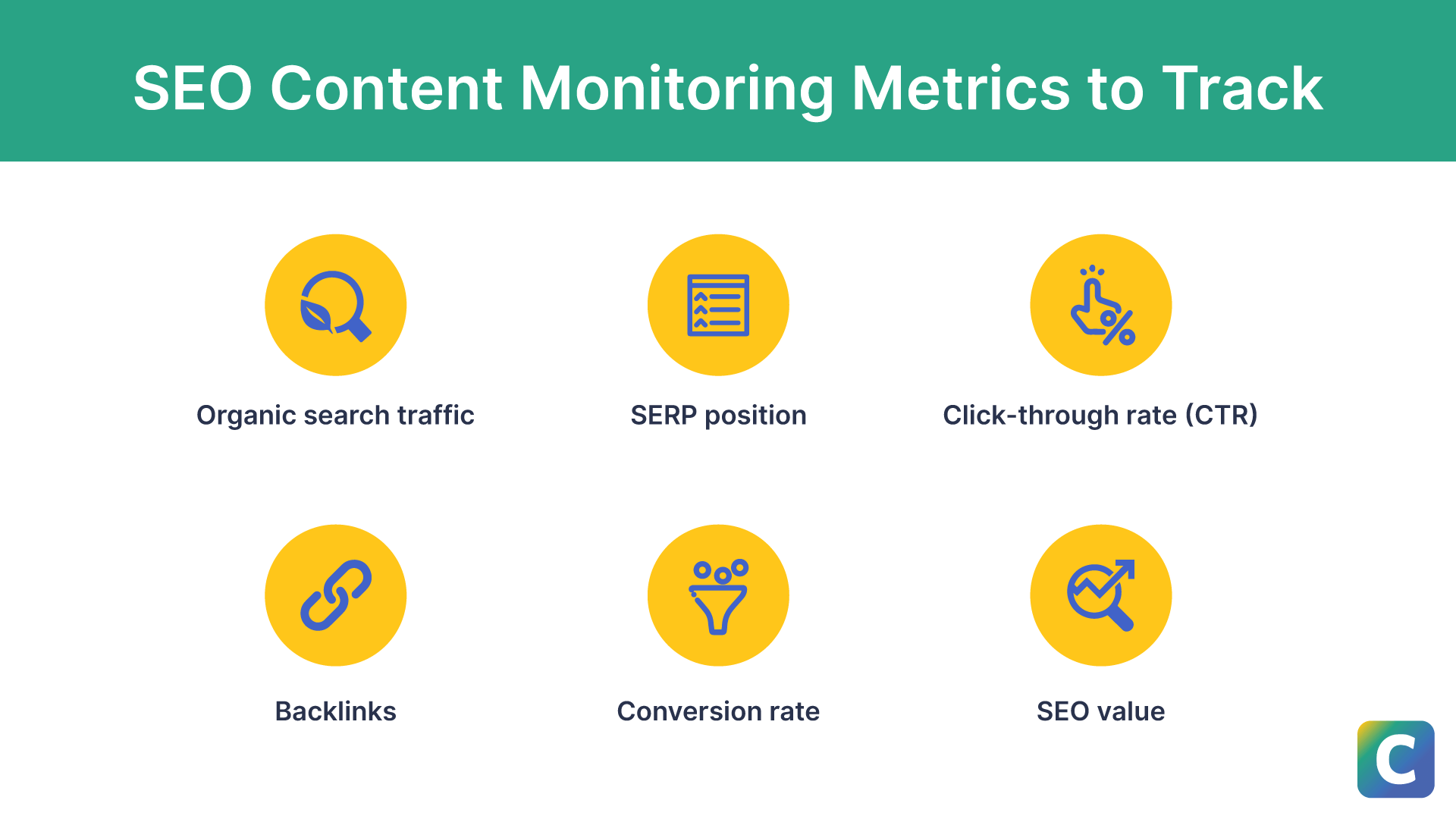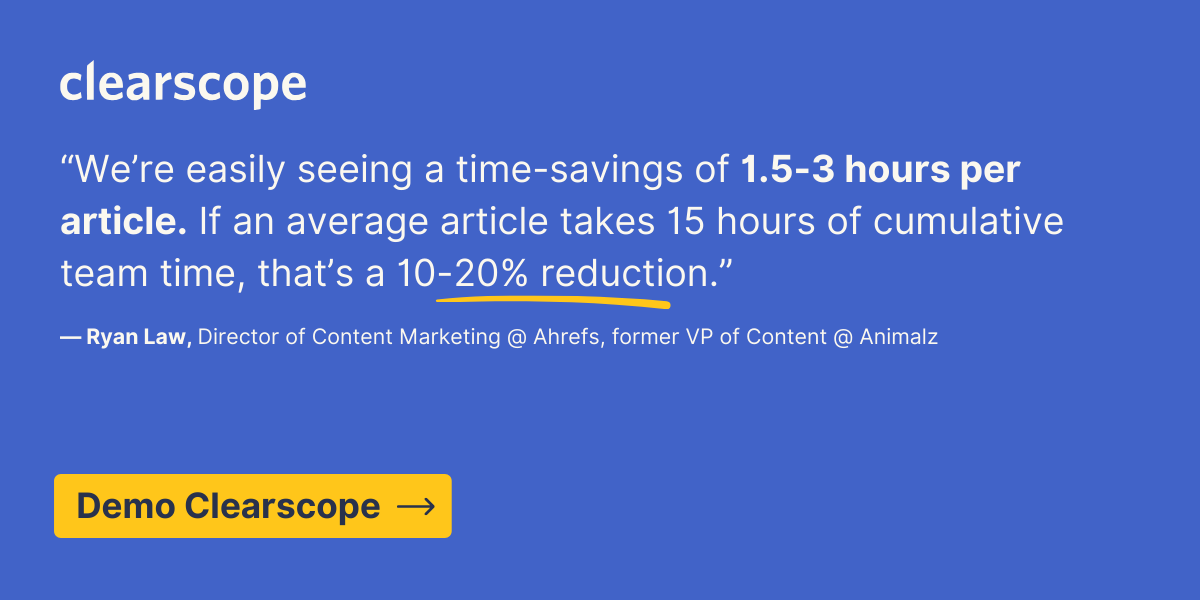What Is Content Quality and Why It Matters for SEO
Topic: Content Marketing
Published:
Written by: Bernard Huang
TL;DR: What is content quality?
Content quality refers to the overall value, relevance, and usefulness of a piece of content to its intended audience.
High-quality content is not only well-written and informative, but it’s also a critical component of search engine optimization (SEO).
It’s designed to meet the needs of users by providing valuable content in an engaging format, ultimately improving your online presence.
In this Clearscope Webinar, Clearscope founder Bernard Huang details what it takes to rank high-quality content in the era of AI.
What makes content "high-quality?”
High-quality content is the gold standard in content marketing and a key factor in a successful SEO strategy.
But what exactly does this mean?
It’s not just about good grammar or pretty visuals—it’s about meeting and exceeding user expectations.
To be considered high-quality, SEO content should:
Be relevant to the target audience and the intent behind the search queries: It should directly answer the questions searchers are asking and be tailored to the needs of your target audience by using relevant keywords and sharply meeting user intent.
Provide in-depth analysis, firsthand experience, and originality: Original content should provide a comprehensive analysis of the topic, offering unique insights and data that aren't available elsewhere.
Provide and excellent user experience and clean readability: You need more than just good copywriting. The content should be easy to read and navigate, with clear headings, subheadings, bullet points, and a logical flow. Great content provides fresh perspectives, which can support higher rankings by keeping users engaged.
Often, it’s a bit easier to understand what is high-quality content when we also define what is low-quality content.
You usually know low-quality content when you see it, but it’s often marked by:
Content that doesn’t meet the search intent or answer the person’s question
Generic information, consensus, or copycat-style content that anyone can get from an AI generated answer or AI generated content platforms
Poorly written, keyword-stuffed articles
Webpages that have a poor user experience (like a high page load time or lots of spammy ads)
A lack of citations for claims made or referenced sources
Outdated or factually incorrect information
Overstuffed articles that feel too long and bury the important information
Content created to “spam” search engines
The basics: How Google’s algorithms evaluate content quality
What we’re going to cover in this section is for beginners who are new strategists and are creating SEO website content for the first time. (Skip ahead if that isn’t you!)
Google’s algorithms use a variety of ranking factors to assess content quality as part of its search engine optimization process.
It looks for signals like relevance to search queries, user engagement metrics, and adherence to SEO best practices.
Google's focus on E-E-A-T (Experience, Expertise, Authoritativeness, and Trustworthiness) plays a crucial role in this evaluation.
Content that demonstrates expertise and provides reliable information is more likely to contribute positively to your website's ranking on search engine results pages (SERPs).
Why content quality matters for SEO
The importance of content quality for search engine rankings
High-quality content is a major driver of website's ranking in search engine results.
When your content is well-optimized, relevant, and engaging, it signals to search engines like Google that your website is a valuable resource.
This can lead to better performance and visibility in search results, making it easier for users to find your content.
Key elements that contribute to better ranking content include:
Including relevant Keywords: Keyword research helps you understand what your audience is searching for and incorporating those target keywords naturally into your content is essential.
Meeting search intent: Providing what your target audience needs, when they need it, and the way they expect to receive the information is crucial to creating quality content that ranks well.
Providing a people-first experience: Write for people, not search engines. High-quality content keeps user engagement high by providing real solutions, and this can keep searchers on your web pages longer, reducing bounce rates and increasing engagement time, both of which are positive signals to search engines.
The importance of quality content in earning organic traffic
Organic traffic—or the visitors who find your site through organic search results—is largely influenced by the quality of your content.
Here’s how:
Content writing that captivates your audience will naturally lead to more engaging content that organically produces shares, backlinks, and overall higher visibility.
By consistently producing high-quality, keyword-optimized content, you can improve your site's SEO success and performance over time, leading to more organic traffic and better rankings.
Sites that focus on producing in-depth, authoritative content with first-party data and real-life examples often see significant improvements in their search engine rankings and organic traffic.
Trustworthiness and E-E-A-T in SEO
E-E-A-T stands for Experience, Expertise, Authoritativeness, and Trustworthiness—all critical factors in determining content quality.
While EEAT isn't a direct ranking factor, it's a crucial component of Google's algorithm.
Google emphasizes these aspects because they ensure that the information presented is reliable and accurate.
Here’s why they matter:
Experience: This refers to first-hand knowledge or experience with the topic. This shows people (and search engines) that you are a real person or expert writing about the topic, and not just creating content to spam the internet.
Expertise: This indicates a deep understanding of the subject matter. So if you’re a running shoe site attempting to give readers advice about which credit cards offer the best rewards, it’s not likely you’ll rank well for the credit card topic. Why? Because you’re a running shoe expert—not a financial expert.
Authoritativeness: This refers to the credibility and reputation of the content creator or website. What signals is your brand sending across the web to demonstrate authority? If you’re a medical website, is your content reviewed by board certified professionals?
Trustworthiness: This encompasses the overall reliability and accuracy of the information presented. This could come from real reviews for your business across the web, or it could be content that cites its sources or is regularly refreshed.
How does content quality work in SEO?
Creating high-quality content is a crucial part of your SEO marketing strategy.
But it’s a multi-step creation process involving research, writing, and optimization—and this is where good content can become great content.
Here’s how to do it:
Research: Begin by understanding your target audience and conducting keyword research to identify what they are searching for. Keyword research tools can be particularly helpful in finding relevant topics and long-tail keywords that match the targeted intent for your audience.
Writing: Craft content that is original, engaging, and provides value to your audience. Use subheadings, bullet points, and meta descriptions to make your content easy to read and understand. Provide clear, actionable tips that help guide your readers to solving their problem or getting the information they need.
Optimization: Ensure your content is SEO-friendly by including target keywords without overdoing it—avoid keyword stuffing. Also, consider the concept of information gain (adding new information not found elsewhere) and entity-rich content (content that clearly identifies the main subjects or entities). Relevant content is key.
People-first content: Always write for your audience first. Understand their needs and pain points, and provide solutions that are easy to digest.
Content formats and their impact on quality
Different types of content formats play a crucial role in how quality is perceived:
Multimedia: Incorporating images, infographics, linked social media posts, and audio (like podcasts) can enhance the quality of your content by making it more engaging and accessible.
Content types: Blogs, case studies, white papers, social media posts, and other formats each contribute to the overall quality of your content strategy. Each type has its place depending on the user intent and the message you want to convey.
Diverse formats: Using a variety of content formats—like video or interactive slides—helps meet different user needs and preferences, which can improve user experience and boost your SEO efforts.
Best practices for ensuring content quality
Measuring your content quality: How to do it
Evaluating the success of your content involves tracking key metrics such as:
Readability: Ensure your content is easy to read and understand. Tools like Clearscope can assess readability and provide recommendations for improvement.
User engagement: Look at how users interact with your content—check out metrics like time on page, bounce rates, and social shares. You can also check out a heat map tool like Hot Jar to get a good indication of the parts of your content that are most important to your readers.
Improving existing content: Regularly update and refine your content to keep it relevant and valuable, which can help increase visibility and drive conversions.

Common content quality pitfalls: What to know
Low-quality content can harm your SEO efforts.
Avoid these common mistakes:
Misunderstanding true search intent: Make sure your content aligns with what users are actually searching for, rather than just focusing on target keywords or high-volume search queries.
Keyword stuffing: Overloading your content with keywords can lead to penalties from search engines. It’s also just not a great experience for your audience. Instead, focus on entity-rich content creation.
Copycat content—and copycat content strategy: Duplicate, generic, copycat or irrelevant content can damage your SEO rankings. Always aim high-value content that meets user needs and provide uniqueness.
Common questions about content quality
Q: What is a content quality score or content grade in SEO?
A content quality score or content grade is a metric used to evaluate the overall quality of your content based on factors like relevance, readability, and SEO optimization.
SEO tool platforms like Clearscope provide insights into how your content scores within the tool and suggests improvements.

Which content creation tools provide the best SEO optimization features?
There are several tools available that can help you optimize your content for SEO.
Clearscope is one of the most popular ones, offering features like keyword research, readability analysis, and content grading to help you create high-quality, SEO-friendly content.
These tools can guide you through the content creation process to ensure you produce informative content that ranks well.
Additional resources
Creating Helpful, Reliable, People-First Content from Google Search Central
Google Search's Guidance About AI-Generated Content from Google Search Central
How to Do Content Pruning to Boost SEO Performance
Systematic content pruning helps you remove or repurpose low-quality content on your website to improve search engine rankings and user experience.
Read moreHow to Get On the First Page of Google SERP: 8 SEO Strategies
We review the best SEO strategies to produce high-quality content & get on the first page of Google search results. See how Clearscope supports your teams.
Read moreWhy Ranch-Style SEO Is Your Future-Proof Content Strategy
Learn what ranch-style SEO is, why it works, and how to use this perspective-driven content strategy to your advantage. Spoiler: It's the future of SEO.
Read more